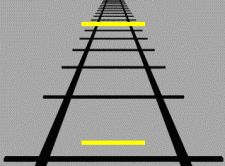During human evolution, our brain developed a bunch of exciting new abilities. However, not everything in our noggin is new; with our brain inheriting a lot of features from our monkey ancestors. As such, we can both be tricked by some of the same optical illusions.
Now, this isn't just some tidbit of trivia we could use to prank monkeys. It sheds light on the core building blocks of our cognition, showing us how our brain interprets the world around it and how long it's been working that way 1.
Plus it reminds us that we did, in fact, evolve from filthy monkey men.
Lining up optical illusions
One of my favourite optical illusions is the Muller-Lyer line. You might not have heard of it, but you've probably seen it.
And in a dramatic turn of events, both humans and monkeys fall prey to this illusion. We both inherited our brains from a common ancestor; complete with similar quirks and foibles 2.
In fact, our brains are so similar that we're tricked for the same reason. It turns out that there's if the arrows at the end are a certain angle, we're much more susceptible to the illusion. And so are monkeys. Those arrows throw us both off 2.
But it doesn't end there. Early results suggest that birds may also fall prey to the Muller-Lyer lines. It seems the cognitive architecture that makes us vulnerable to the arrows may be as old as our common ancestor with them, some 320 million years ago 2.
Scrambled Legs
One of the most common things primates have to deal with is other primates. As such, our brain has gotten very good at recognising other members of our species and what they might be up to. In fact, we're so good at it we can spot people that aren't even there.
This speed (and oversensitivity) is possible because our brain takes shortcuts. See three lines spaced out like eyes and a mouth? Don't bother trying to figure out what it is, skip to processing it as a face 1.
It turns out that there are specific triggers that make our brain take these shortcuts. If we tamper with them, it becomes infinitely harder for us to recognise the picture. Something as simple as flipping the face upside down makes us slower at spotting it 3.
Similarly, we're pretty good at identifying the human bodies and their posture. Presumably to help us quickly process if someone's coming at us for a hug or a fight. But again, a minor tweak can make it hard for us to follow. Specifically, scrambling the limbs 1.
And of course, since we evolved from filthy monkey men it turns out that we inherited many of these features from them. Thus, they also have trouble dealing with upside down faces 3 or scrambled legs 1.
A Ponzo scheme
The last of these optical illusions we're dealing with today is the Ponzo line. This is when two lines are placed on a background that appears to be stretching away from the viewer (like a road leading into the distance). Whilst they look different lengths, they're actually the same!

As you might imagine, the background in a Ponzo illusion is important. It's what causes the whole effect. If you place the illusion over an upside-down landscape then humans are better at spotting the trick. However, monkeys appear equally as vulnerable, regardless of the background 5.
Nobody is quite sure why that is, but it's nice to know that there are some differences between us and filthy monkey men. Just as many as you may have thought.

